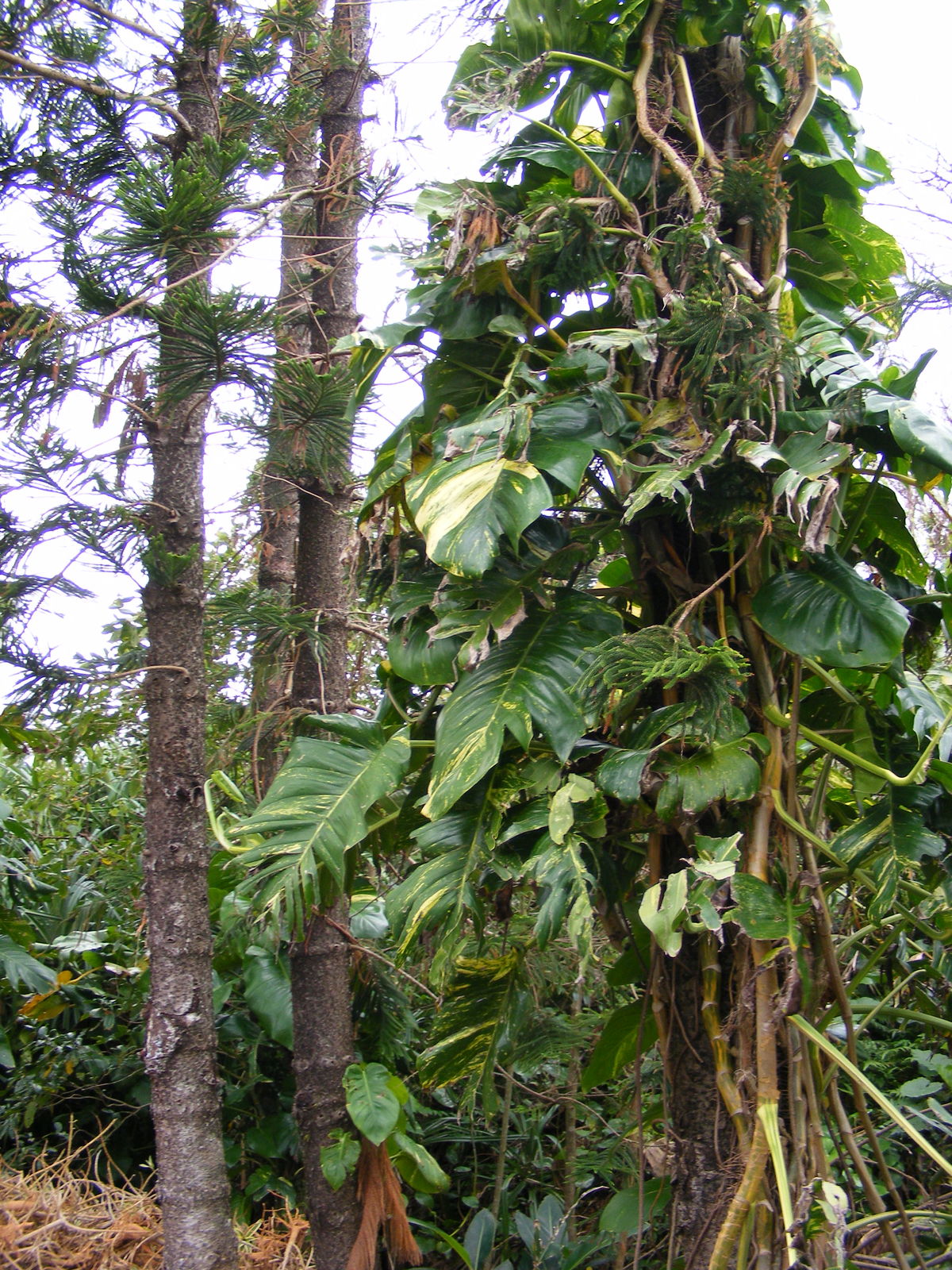Family: Araceae
Author: (Linden & André) G.S.Bunting
Bibliography: Ann. Missouri Bot. Gard. 50: 28 (1964)
Year: 1964
Status: accepted
Rank: species
Genus: Epipremnum
Vegetable: False
Observations: Society Is. (Moorea)
Description
Devil’s-ivy, scientifically known as Epipremnum aureum, is a popular and hardy houseplant that has gained popularity worldwide for its attractive appearance and low maintenance requirements. This plant is a member of the Araceae family and is known for its striking, heart-shaped leaves, which often display a mesmerizing mix of green and yellow variegation.
Originally documented in the Annals of the Missouri Botanical Garden in 1964 by G.S. Bunting, based on work by Linden and André, Devil’s-ivy hails from the tropical forests of the Society Islands, particularly Moorea. In its natural habitat, Epipremnum aureum thrives in the warm, humid conditions of the tropics, often found climbing trees and spreading along the forest floor.
One of the most distinctive characteristics of Devil’s-ivy is its resilience and adaptability. It can prosper in a variety of indoor environments, making it an ideal choice for both novice and experienced plant enthusiasts. This plant can tolerate low light conditions, although it prefers bright, indirect light for optimal growth and variegation.
Another appealing feature of Devil’s-ivy is its air-purifying properties. Research has shown that Epipremnum aureum can effectively filter toxins such as formaldehyde, xylene, and benzene from the air, contributing to a healthier indoor atmosphere.
Caring for Devil’s-ivy is straightforward. It requires well-draining soil and should be watered when the topsoil feels dry to the touch. Overwatering can lead to root rot, so it’s important to ensure that the plant is not left sitting in water. Fertilizing every few months with a balanced houseplant fertilizer will support healthy growth and vibrant foliage.
In summary, Devil’s-ivy (Epipremnum aureum) is a versatile and attractive plant that is well-suited for indoor living. Its ability to adapt to various light conditions, coupled with its air-purifying benefits, makes it a valuable addition to any home or office space.
Common Names
Eng: devil’s-ivy, golden hunter’s-robe, golden pothos, tonga vine, pothos vine, variegated philodendron
Deu: goldene efeutute
Swe: gullranka
Por: jiboia-verde
En: Devil’s-ivy, Golden hunter’s-robe, Golden pothos, Tonga Vine, Pothos vine, Variegated philodendron
De: Goldene Efeutute
Pt: Jiboia-verde
Sv: Gullranka
Synonyms
- Scindapsus aureus ((Linden & André) Engl.)
- Pothos aureus (Linden & André)
- Rhaphidophora aurea ((Linden & André) Birdsey)
- Epipremnum mooreense (Nadeaud)
Distribution
- Society Is. (native)
- Assam (introduced)
- Bangladesh (introduced)
- Bermuda (introduced)
- Brazil Northeast (introduced)
- Brazil Southeast (introduced)
- Cameroon (introduced)
- Caroline Is. (introduced)
- Chagos Archipelago (introduced)
- China Southeast (introduced)
- Comoros (introduced)
- Cook Is. (introduced)
- Costa Rica (introduced)
- Cuba (introduced)
- Dominican Republic (introduced)
- Ecuador (introduced)
- Fiji (introduced)
- Florida (introduced)
- Guinea (introduced)
- Haiti (introduced)
- Hawaii (introduced)
- India (introduced)
- Ivory Coast (introduced)
- Kenya (introduced)
- Leeward Is. (introduced)
- Lesser Sunda Is. (introduced)
- Line Is. (introduced)
- Malaya (introduced)
- Nansei-shoto (introduced)
- Ogasawara-shoto (introduced)
- Puerto Rico (introduced)
- Queensland (introduced)
- Seychelles (introduced)
- Solomon Is. (introduced)
- Sri Lanka (introduced)
- Suriname (introduced)
- Thailand (introduced)
- Trinidad-Tobago (introduced)
- Tuamotu (introduced)
- Venezuelan Antilles (introduced)
Additional Images
Leaf
Taken Dec 25, 2021 by Magnun Paula Pereira (cc-by-sa)
Taken Jul 7, 2019 by Alexandre Rispo (cc-by-sa)
Taken Jul 14, 2021 by Ghislaine JULIAN (cc-by-sa)
Taken Jul 11, 2019 by Hung Nguyenduc (cc-by-sa)
Taken Aug 29, 2020 by Decarli Alessandro (cc-by-sa)
Habit
Taken Nov 17, 2021 by Tutty Lee (cc-by-sa)
Taken Jan 29, 2020 by Terezinha Varga Garcia (cc-by-sa)
Taken Apr 14, 2021 by Ha Anna (cc-by-sa)
Taken Nov 10, 2021 by Kasia rutkowska (cc-by-sa)
Taken Jan 1, 2022 by Joseph Dupont (cc-by-sa)
Other
Taken Jun 20, 2022 by Trap Hers (cc-by-sa)
Taken Jan 3, 2022 by Villena Rojas Marcelo (cc-by-sa)
Taken Aug 31, 2022 by M. Hedayat (cc-by-sa)
Taken Jul 4, 2019 by Łącka Magdalena (cc-by-sa)
Taken Feb 12, 2021 by Cruz Leo (cc-by-sa)
Bark
Taken Nov 28, 2022 by KP Laer (cc-by-sa)
Taken May 3, 2022 by Carmen Perez cubero (cc-by-sa)
Taken Dec 20, 2020 by Hannah Heart (cc-by-sa)
Taken Sep 30, 2021 by israel Garcia (cc-by-sa)
Taken Nov 5, 2020 by Alessandro de La Palme (cc-by-sa)
Flower
Taken Jun 6, 2022 by Kelvyn Santana (cc-by-sa)
Taken Sep 2, 2021 by Andrew Keshi (cc-by-sa)
Taken Jan 9, 2022 by Daniela Cuevas (cc-by-sa)
Taken Sep 21, 2020 by Szanyi Gábor (cc-by-sa)
Taken Feb 19, 2021 by Lili Kimmel (cc-by-sa)
Fruit
Taken Mar 26, 2022 by Stefano Gianazzi (cc-by-sa)
Taken Apr 15, 2021 by Tharakan Tharakan (cc-by-sa)
Taken Feb 11, 2022 by msieurico (cc-by-sa)
Taken Mar 10, 2020 by Corinna Johanning (cc-by-sa)
Taken Oct 5, 2022 by Samyra Saray (cc-by-sa)

© copyright of the Board of Trustees of the Royal Botanic Gardens, Kew.

© copyright of the Board of Trustees of the Royal Botanic Gardens, Kew.

© copyright of the Board of Trustees of the Royal Botanic Gardens, Kew.
Sources
- WFO (No URL)
- IPNI (No URL)
- GBIF (https://www.gbif.org/species/2868323)
- POWO (http://powo.science.kew.org/taxon/urn:lsid:ipni.org:names:87014-1)
- PlantNet (https://identify.plantnet.org/species/the-plant-list/Epipremnum aureum (Linden & André) G.S.Bunting)






























